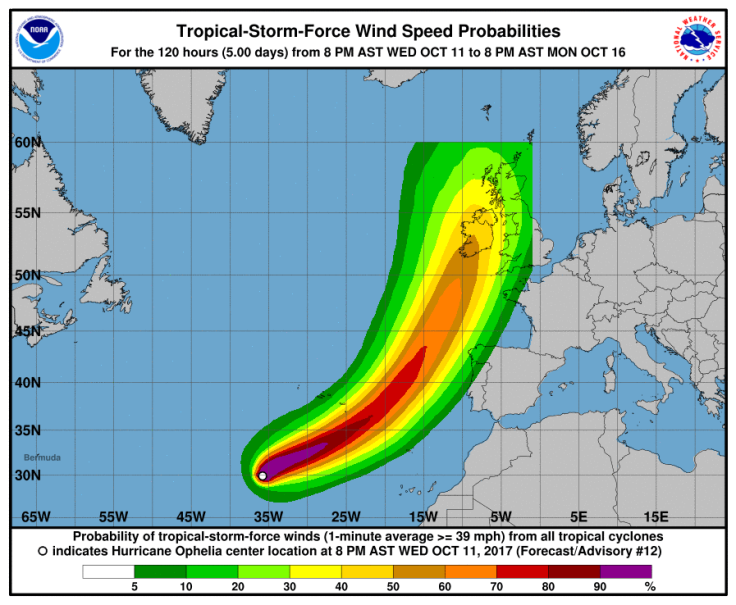Hurricane Ophelia 2017 Projected Path As Tropical Storm Becomes More Severe

Tropical storm Ophelia strengthened to the status of a Category 1 hurricane Wednesday and is currently heading toward the coast of Ireland.
The hurricane is currently moving at three mph in a northeastern direction, carrying 85 mph wind speed and wind pressure of 986 mb. It is expected to follow in that general direction till Thursday and pick up speed by the beginning of Friday.
It is currently located 745 miles southwest of the Azores, but as it gains more speed by the end of the week, it could head northeast toward the south of Azores. After that, if it curls northeast along off the Iberian Peninsula, it will remain an intense storm near or off the coast of Ireland on Monday.
It is too early to tell if Hurricane Ophelia will definitely make landfall in Ireland or not. The eye of the hurricane is expected to stay offshore. However, if it does strike the Irish coast, it will not do so as a hurricane, but a tropical storm. No coastal watches or warnings have been issued so far in any of the European coasts, Nola reported.
Nevertheless, Hurricane Ophelia is expected to bring an intense blast of winds to the Emerald Isle, and the western half of Ireland early next week. Certain parts of the U.K. can also be impacted by wind and rain, starting Monday. Stormy weather could impact eastern portions of the Portuguese archipelago this weekend.

Although it initially seemed like Hurricane Ophelia was headed toward the already storm-battered Caribbean islands, it soon changed its course and instead of crossing the Atlantic Ocean, proceeded toward the coast of Spain instead, Business Insider reported.
Ophelia is the 10th tropical storm in a row to reach the status of a hurricane in the Atlantic Ocean this season, a record that was met in the years 1878, 1886 and 1893. However, according to Mashable, there is no way of telling for sure if the record was repeated in the latter half of the twentieth century, due to the absence of substantial satellite measurements at the time.
Latest models show #Ophelia may pose a rare hurricane-force threat to western Europe this weekend. pic.twitter.com/5uGwbe8PY6
— Eric Holthaus (@EricHolthaus) October 10, 2017
According to NOAA's historical hurricane database, only 15 hurricanes have passed within 200 nautical miles of the Azores since 1851. Incidentally, all of them have arrived in the months of August or September, except for Hurricane Fran, which swept past the area in October 1973 and Hurricane Alex in January 2016.
Previously, only two tropical cyclones have struck the coasts of Spain and Portugal in the past – a transitioning hurricane in October 1842 and Hurricane Vince, as a tropical depression, in October 2005.
Hurricane Ophelia took shape outside of the "main development region," where most of the Atlantic hurricanes are known to form. Nevertheless, it has the potential to set records for the strongest storm to form in its location.
There are no possibilities of Ophelia impacting the United States as it heads to Europe next week, according to Weather. The severity of the impact on Ireland due to Hurricane Ophelia would depend on the exact track followed by the Category 1 storm in the next few days.
© Copyright IBTimes 2024. All rights reserved.












